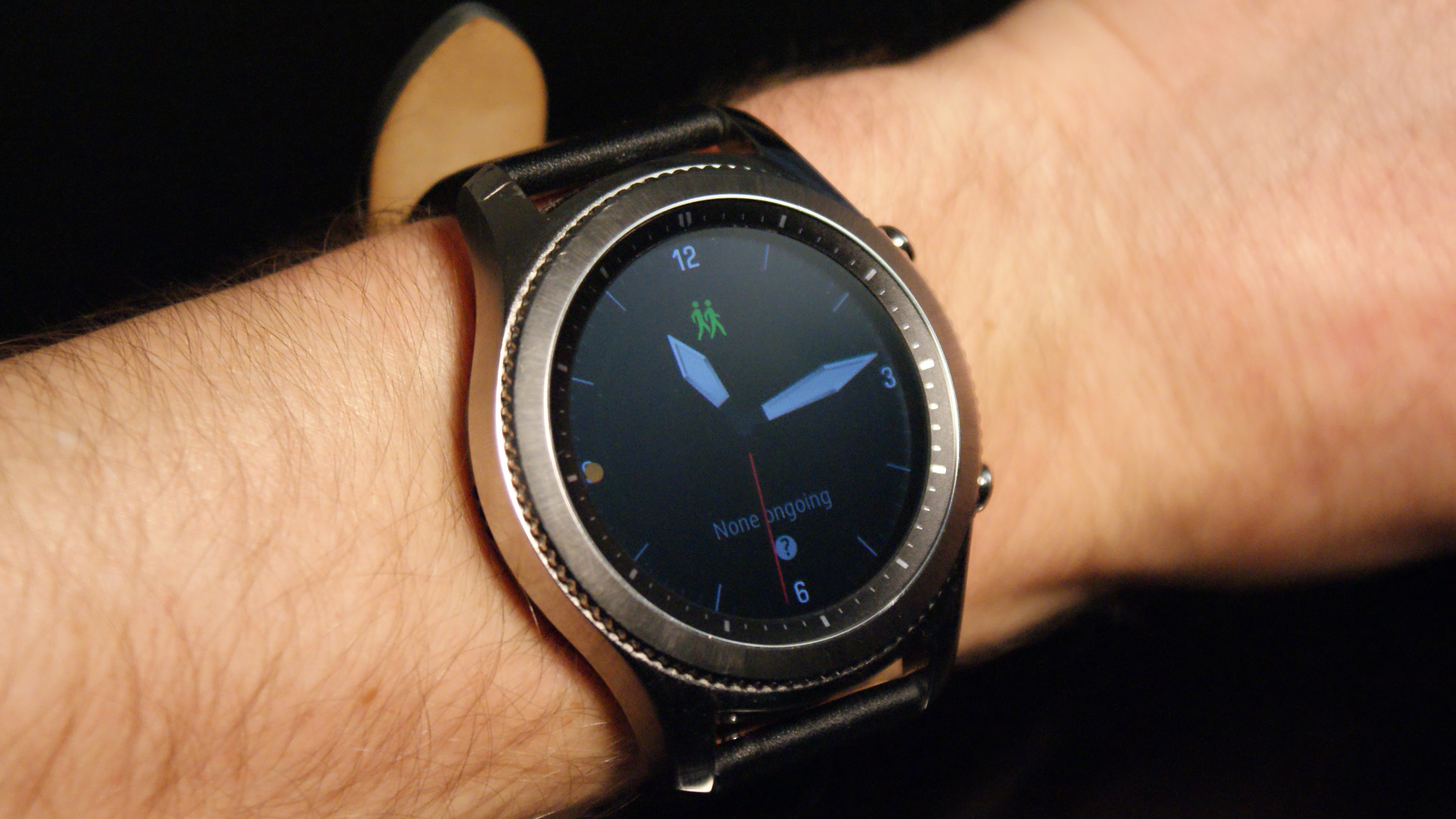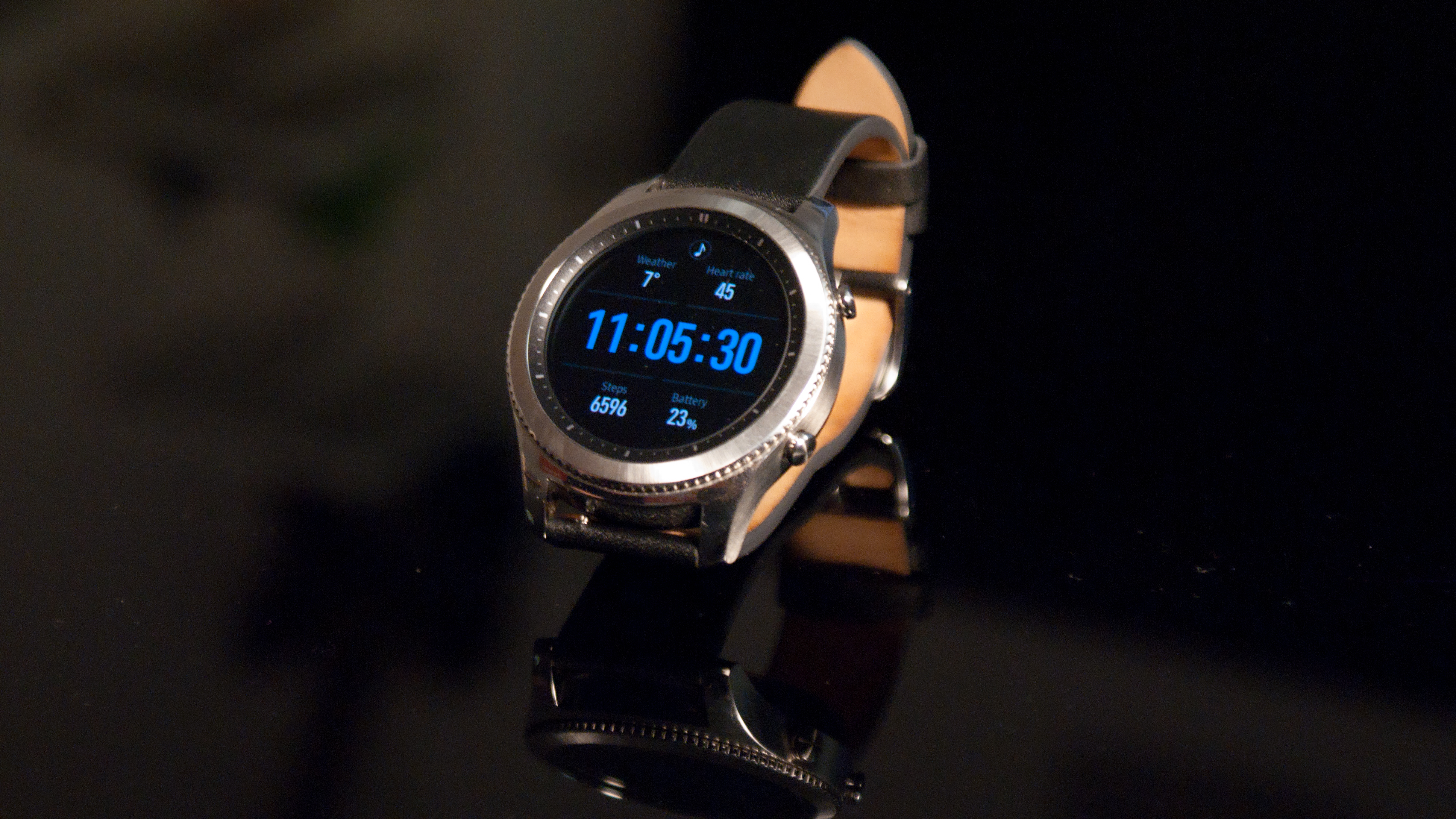Why you can trust TechRadar
With the lack of apps available for the Samsung Gear S3, its abilities in the fitness space come to the fore. And the good news: it's fully-featured in that department.
There's GPS on board for solid run tracking, an accelerometer for counting repetitions of cross-fit activities, smart integration with Samsung's S Health platform and a few other nuggets to get you feeling more active throughout the day.
The daily move nudges are the best we've ever seen on a smartwatch. The animations to get you moving each hour are neat, showing little snoozing shoes and highlighting that you're being sedentary rather than just telling you to move irrationally.

There are also little tips embedded to help you get the most out of your daily routine: for instance, if you're not moving a lot, the Gear S3 will entice you to do some stretches and guide you through the process, counting as you go using the accelerometer, which feels far more interactive than just being told to stand up.
However, that's the end of the decent tracking. If you head into the fitness app you're greeted with all manner of options to get you active, from running to lunges to cycling to crunches.
Trying the bodyweight options, the accuracy was thoroughly mixed. Squats were perfect, with each on tracked properly. However lunges, crunches and star jumps were all just utterly, utterly useless, with nothing being checked off properly, so the workout was redundant.
Compare that to a fitness tracker like the Moov Now, and you'll see how poorly this performs. It's perfectly possible to count how many star jumps one is doing, but Samsung's watch doesn't.
When it comes to the run accuracy, that was middling too. Over the long run distance, things were OK - only 0.1 miles out over a 32 mile distance, which gave us high confidence in the Gear S3 as a running watch.
But SO MANY times the run was erratic and inaccurate, with things like a random mile adding onto the distance for no reason or suddenly failing to track me for a short time.
This wasn't regular, but combined with no way of knowing at the start if you've got a GPS lock (we assume in the same way as the Apple Watch, where it'll fill in the data with the accelerometer until it gets a GPS lock) it's hard to trust this watch as a proper running tracker.
The screen is large and bright though, so seeing what you're doing isn't too hard. The 'lift to wake' accuracy is strong, with every flick of the wrist showing the time, distance or pace instantly.

However, it'll sometimes take a second to update the screen with the current information, so you'll look down and panic that you've only done a couple of miles before it suddenly bounces up to four, and you can breathe a (very rapid) sigh of relief.
You can tap to change what's on the screen pretty well, but you can’t choose the order of what's being shown, so you'll have to make do with what's there and learn how many times you'll need to swipe to see your heart rate data or distance.
And there are training programs designed to help you increase speed or endurance... but we could not work these out.
There were constant commands to slow down or speed up, but with no easy way to track your fitness levels it was hard to see how accurate and useful these could be, or to get explanation on how they worked.
One of the good ways to see how fit you are is through the heart rate monitor - and we feel bad for criticising Apple's version now, given how bad Samsung's is.
It's the embodiment of stupidity on a wrist, with so many false readings falling out. Even being used on a 'good arm', which should have more blood flow and a good contact zone for checking, saw random results fall out.
At no point did we have a heart rate of 240+ beats per minute. We might be dead if that was the case.
Over time, the heart rate accuracy will snap back into place, but it's not dependable in any way, so you'll need to connect a chest strap instead.
Given the lack of decent running apps though it's hard to recommend this as a running watch, despite the pleasant interface when scrutinising said run on the S Health app of your smartphone.

(One great thing Samsung does: letting you download your GPX file so you can plug that into online sources. It's not an easy way to do things, but at least your data isn't locked away like it is on Apple's timepiece.).
The Samsung Gear S3 has another key feature that we like: automatic workout detection. If you're running, cycling, walking or doing something dynamic (like weights or just the general housework) it'll begin to monitor you after 10 minutes, and estimate your calorie burn.
It's a really nice feature and works flawlessly - except for the fact the watch through, time and again, that we were cycling when driving at over 50 miles per hour.
Not just once, but multiple times. What kind of repetitive motion was it seeing that, combined with the insane speeds, told it that cycling was the obvious activity happening?
This data does help build a good picture of your day though, and we love the overall calorie counter each day.
The accuracy is up for debate (during the long 32 mile run, the Samsung Gear S3 gave a reading that was WAY in excess of the other watches, despite having the same data) but being able to see how your sleep, sedentary periods of the day, active sessions and even walks to work all add up feels like a really rounded way of checking out how active you are.
The sleep tracking isn't bad either - although it's the most 'generous' tracker we've ever seen. Where other options constantly point out that we need to be more restful in our snoozing, the Gear S3 delights in telling us that we were motionless for most of the night.
As we're asleep it's hard to tell which is telling the truth, but Samsung's watch does seem more forgiving.
One annoying bug that keeps coming up: it'll split up sleep sessions randomly in the night. Over a two week test, there were three instances where, upon waking, we were told that we'd only got an hour or two's sleep, where a deeper look at the stats in the S Health app showed for some reason the watch had just given up tracking for some reason.
That, or we're sleepwalking terribly suddenly.
Battery life
The battery shoved into the Samsung Gear S3 is 380mAh, which should last for a decent amount of time. And in truth you'll easily get a couple of day's use out of this watch, and far more if you don't do anything with the GPS tracking or fire it up regularly.
Well, 'far' more is a bit of an overstatement - you'll get closer to three days' use on a single charge, but for a large touchscreen like this it's not a bad result at all. It's also very quick to charge considering it's wireless, just being dropped into the dock and suddenly fired up.
It shows that Apple is being rather tight with its charger offerings: Samsung's plastic dock is robust but doesn't feel expensive, and there's no reason Apple couldn't have offered the same thing for the high price of the Apple Watch.
If you're down to no charge left on the watch, there's no speedy juicing on offer though - you'll need to wait a couple of hours to get it close to the maximum, and the 'time remaining' counter isn't too impressive either -it'll bounce around rather erratically.
In terms of how well it lasts when running, the long test showed that the Samsung Gear S3 is one of the better performers when it comes to power management on the go.

It'll track your heart rate and your speed / distance for four hours and only have lost 50% of the battery, which is far better than Apple's option.
However, leave the Always On Display running and stream music over Bluetooth when you’re going for a jog, and you can actually drop nearly 50% of the battery life in under an hour or two - the Gear S3 does not like everything running at once.
We ran every day with the Gear S3 strapped to the wrist, and found that if you're working out for about an hour a day it'll still get to 48 hours without needing to be juiced back up as long as you’re careful.
It’s also nice that there’s a low-power mode: switch it on and the Gear S3 will show you limited information in monochrome, which really extends the life of your watch.
There’s even a ‘I’m nearly out of juice’ mode for when things are dangerously low, but that’s pretty much useless as we could NOT work out how to make the time show up, despite still being turned on.
Since we've initially reviewed the Samsung Gear S3, the company has updated the software and says the battery life will be improved. We've yet to test this, but we hope to do so for a future update to this review.

Gareth has been part of the consumer technology world in a career spanning three decades. He started life as a staff writer on the fledgling TechRadar, and has grew with the site (primarily as phones, tablets and wearables editor) until becoming Global Editor in Chief in 2018. Gareth has written over 4,000 articles for TechRadar, has contributed expert insight to a number of other publications, chaired panels on zeitgeist technologies, presented at the Gadget Show Live as well as representing the brand on TV and radio for multiple channels including Sky, BBC, ITV and Al-Jazeera. Passionate about fitness, he can bore anyone rigid about stress management, sleep tracking, heart rate variance as well as bemoaning something about the latest iPhone, Galaxy or OLED TV.
